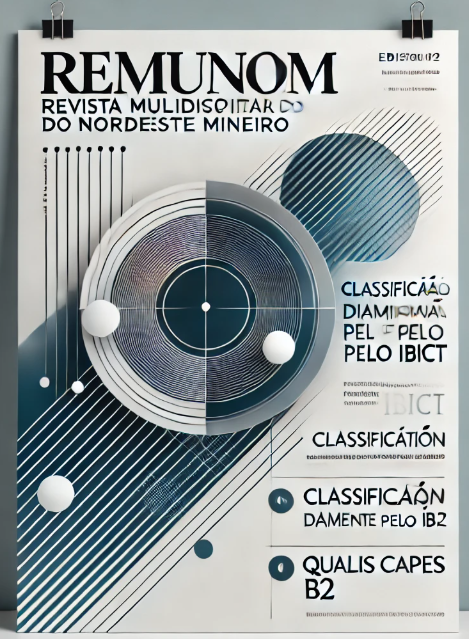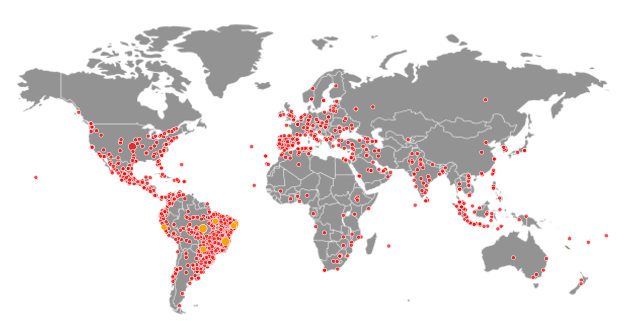DESEMPENHO ZOOTÉCNICO DE LEITÕES ALIMENTADOS COM FARINHA DE RESÍDUO DO PROCESSAMENTO AGROINDUSTRIAL DE Psdium guajava L
DOI:
https://doi.org/10.61164/rmnm.v8i1.3889Palavras-chave:
Goiaba, Promotores de desempenho, Alimentos alternativosResumo
A goiaba (Psidium guajava L.) é uma frutífera tropical resistente e produtiva, e seu resíduo de processamento (sementes e polpa residual) é rico em nutrientes e tem potencial para ser utilizado como ingrediente em rações para alimentação animal. Foram delineados 11 tratamentos por metodologia de superfície de resposta, tendo utilizado como parâmetro duas variáveis, farinha de goiaba (FG) e amoxicilina. Foram utilizados 3 animais por unidade experimental, totalizando 33 leitões com idade inicial de 28 dias. Foi observado uma variação no desempenho (CMD, GPD e CA) entre os diferentes tratamentos, diminuindo tanto a FG quanto o antibiótico. A não significância dos dados para GPD pode ser devido à variabilidade das amostras, incluindo diferenças individuais entre os animais e fatores não controlados. A adição de altos níveis de FG pode ter afetado a palatabilidade e digestibilidade da ração, levando a uma redução no consumo de ração pelos leitões. A melhor conversão alimentar foi observada com níveis moderados de inclusão de FG e antibiótico. A relação entre farinha de goiaba (FG) e antibióticos depende da concentração e proporção de cada componente, influenciada pela dieta e saúde dos animais, podendo ter efeitos benéficos ou antagonistas. A farinha de goiaba é uma opção promissora para promover a saúde intestinal e melhorar o desempenho dos suínos, desde que seja incorporada adequadamente às dietas e considerando fatores como concentração, fonte e características individuais dos animais.
Downloads
Referências
ALI, Q.; MA, S.; LA, S.; GUO, Z.; LIU, B.; GAO, Z.; FAROOQ, U.; WANG, Z.; ZHU, X.; CUI, Y. Microbial Short-Chain Fatty Acids: A Bridge between Dietary Fibers and Poultry Gut Health. A Review. Anim. Biosci. v.35, p.1461–1478. 2022 DOI: https://doi.org/10.5713/ab.21.0562
CÂNDIDO, T. R. S.; MENDONÇA, R. S.; LINS, U. M. D. B. L.; DE SOUZA, A. F.; RODRIGUEZ, D. M.; DE CAMPOS-TAKAKI, G. M.; DA SILVA ANDRADE, R. F. Production of biosurfactants by Mucoralean fungi isolated from Caatinga bioma soilusing industrial waste as renewable substrates.Research, Society and Development, v.11, n.2, e13411225332-e13411225332, 2022. DOI: https://doi.org/10.33448/rsd-v11i2.25332
CRUZ, H.; MEDEIROS, A. Potencialidade das folhas da goiabeira em formulações cosméticas. Enciclopedia biosfera, v.20, n.43, p.156-171, 2023. DOI: https://doi.org/10.18677/EnciBio_2023A13
FALCONER, D. S.; MACKAY, T. F. C. Introduction to quantitative genetics. Longman. 4.ed, Addison Wesley Longman, Harlow.1996.
GRESSE, R.; DUNIERE, L.; CHAUCHEYRAS-DURAND, F.; BLANQUET-DIOT, S. Microbiota composition and functional profiling throughout the gastrointestinal tract of commercial weaning piglets. Microorganisms, Basel, v.7, n.9, p.343, 2019. DOI: https://doi.org/10.3390/microorganisms7090343
HUANG, Q.; LIU, X.; ZHAO, G.; HU, T.; WANG, Y. Potential and challenges of tannins as an alternative to in-feed antibiotics for farm animal production. Anim. Nutr. v.4, p.137–150, 2018. DOI: https://doi.org/10.1016/j.aninu.2017.09.004
IBM SPSS Statistics 21. IBM. 2012. Software. Disponível em: <http://www01.ibm.com/software/analytics/spss/products/statistics/>
NASSARAWA, S. S.; NAYIK, G. A.; GUPTA, S. D.; ARECHE, F. O.; JAGDALE, Y. D.; ANSARI, M. J.; HEMEG, H. A.; AL-FARGA, A.; ALOTAIBI, S. S. Aspectos químicos das interações polifenol-proteína e sua atividade antibacteriana. Crítico. Rev. Nutr., v.27, p.1–24, 2022.
OLCHOWIK-GRABAREK, E. G.; SĘKOWSKI, S.; KWIATEK, A.; PŁACZKIEWICZ, J.; ABDULLADJANOVA, N.; SHLYONSKY, V.; SWIECICKA, I.; ZAMARAEVA, M. The structural changes in the membranes of Staphylococcus aureus caused by hydrolysable tannins witness their antibacterial activity. Membranes, v.12, p.1124. 2022. DOI: https://doi.org/10.3390/membranes12111124
PANDEY, A.; NAYAK, S.; KHARE, A.; SHARMA, R.; CHOURASIYA, A.; REDDY, B. V. V.; DANIEL, RISHEEN G.; Perspectives in the use of tannins in animal production & health: a review. J. Livestock Sci. v.13, p.112-119, 2022. DOI: https://doi.org/10.33259/JLivestSci.2022.112-119
RIBEIRO, B. B. Aspectos comerciais da cultura da goiaba no Brasil. Trabalho de Conclusão de Curso (Bacharelado em Agronomia) — Universidade de Brasília, Brasília - DF, 2021.
STEEL, R. G. D.; TORRIE, J. H. Principles and procedures of statistics: A biometrical approach. Nova York: McGraw-Hill, 1980.
TEIXEIRA, L.; MACHADO, G. S.; VILELLA, L. M.; SCHROEDER, B.; KESLER, A. M.; TREVIZAN, L.; PINTO, C. F. D. Efeito da substituição parcial de milho por sorgo e taninos hidrolisáveis em dietas para cães adultos. In: XVII Congresso Brasileiro de Nutrição Animal Pet, Anais... Campinas. XVII CBNA Pet, 2018.
XU, Z.; DU, Y.; LI, N.; GENG, H.; ALI, Q.; LI, X.; GAO, Y.; WANG, Y.; XING, R.; WU, J. Effects of Alfalfa Meal on Quality and Function of Pork Meatballs. Food Sci. Nutr. v.10, p.2601–2610, 2022. DOI: https://doi.org/10.1002/fsn3.2865
Downloads
Publicado
Edição
Seção
Licença
Copyright (c) 2025 Revista Multidisciplinar do Nordeste Mineiro

Este trabalho está licenciado sob uma licença Creative Commons Attribution-NonCommercial-ShareAlike 4.0 International License.
Autores que publicam nesta revista concordam com os seguintes termos:
- Autores mantém os direitos autorais e concedem à revista o direito de primeira publicação, com o trabalho simultaneamente licenciado sob a Licença Creative Commons Attribution que permite o compartilhamento do trabalho com reconhecimento da autoria e publicação inicial nesta revista;
- Autores têm autorização para assumir contratos adicionais separadamente, para distribuição não-exclusiva da versão do trabalho publicada nesta revista (ex.: publicar em repositório institucional ou como capítulo de livro), com reconhecimento de autoria e publicação inicial nesta revista, desde que adpatado ao template do repositório em questão;
- Autores têm permissão e são estimulados a publicar e distribuir seu trabalho online (ex.: em repositórios institucionais ou na sua página pessoal) a qualquer ponto antes ou durante o processo editorial, já que isso pode gerar alterações produtivas, bem como aumentar o impacto e a citação do trabalho publicado (Veja O Efeito do Acesso Livre).
- Os autores são responsáveis por inserir corretamente seus dados, incluindo nome, palavras-chave, resumos e demais informações, definindo assim a forma como desejam ser citados. Dessa forma, o corpo editorial da revista não se responsabiliza por eventuais erros ou inconsistências nesses registros.
POLÍTICA DE PRIVACIDADE
Os nomes e endereços informados nesta revista serão usados exclusivamente para os serviços prestados por esta publicação, não sendo disponibilizados para outras finalidades ou a terceiros.
Obs: todo o conteúdo do trabalho é de responsabilidade do autor e orientador.







